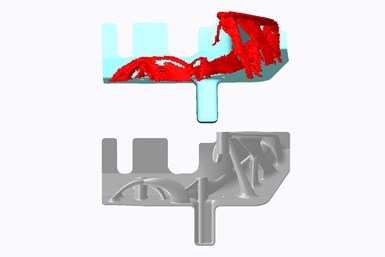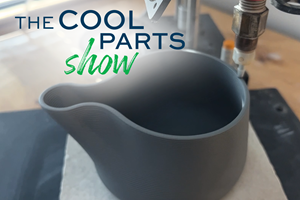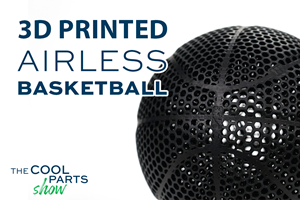GRM Develops Software for OverHiPP Project to Improve Accuracy of Digital Twins
As part of an OverHiPP study, GRM has created software that enables users to virtually model and analyze 3D printed structures at a level of detail never seen before — an accurate digital twin can now be generated, enabling precise design decisions to be made.
Simulation model. Top photo shows optimized simulation result, while bottom photo shows CAD solution based on the simulation data. Source: GRM
GRM, a TriMech Group company, recently participated in a two-year OverHiPP (overprinting with high-performance polymers) project funded by Innovate UK which focused on developing and optimizing a new hybrid manufacturing technique for overprinting 3D printed material onto composite sheets.
Overprinting is a new approach that takes the benefits from a number of existing techniques, specifically from overmolding, resin transfer molding (RTM) and 3D printing. The benefits of this approach include low tooling costs, increased flexibility, rapid changeover of material and low material waste. One challenge with it, however, is the limited knowledge and technologies available.
Recent developments in five-axis 3D printing hardware have enabled projects to push the technological limits further by reducing the need for support structures, enabling manufacturing shapes not previously possible, even with conventional 3D printing, and, pertinently, overprinting material onto existing components. However, simulation techniques for such 3D printed structures have not developed at the same pace, the company says. This is a key area that GRM has been working on solutions.
GRM Consulting is a specialist design and topology optimization software company, with extensive knowledge and experience in developing finite element analysis (FEA) programs across a wide range of disciplines. The company has been developing new software for the OverHiPP project to provide insight, guidance and confidence in 3D printed components by improving the accuracy of digital twins.
The tool path and infill patterns make 5-axis 3D printed structures highly anisotropic in nature. This can make it difficult to accurately model these properties into a digital twin and gain insight into structural performance and failure modes. Moreover, it is almost impossible for a human to manually model the correct material orientation onto each element in an FEA model. GRM has solved this problem by developing software that can automatically replicate a toolpath in an FEA model. Based on a proprietary G-Code reader that can analyze and determine tool path properties before converting it into a digital twin format enables allows for the precise filament orientations and infill cavities to be considered when running structural simulations.
GRM has rigorously tested its results. One such test investigated the feasibility of 3D printing a hyper-car foot rest. This included a number of topology optimization studies being investigated to determine key load paths and structural performance. The final results were interpreted and modelled by GRM for manufacture.
The study aimed to determine the optimal build directions using the minimal amount of material to best support the assessed load cases. From this, a CAD model was then created in SolidWorks based on the topology results, ready for manufacture at the Centre for Additive Layer Manufacturing (CALM) at Exeter University using a high-temperature polyamide from Lehvoss. Local features, such as shoulder bolt mounts, were added and design for additive manufacturing (DFAM) drawings were generated.
It was clear from both the simulation and test results that a five-fold difference was found in both the stiffness and strength performance when printing in poor and optimal directions.
As part of the OverHiPP project, GRM has enabled users to virtually model and analyze 3D printed structures at a level of detail never seen before. An accurate digital twin can now be generated, enabling precise design decisions to be made, by creating updated Nastran/Abaqus models. All of these software features have strong correlation to physical tests, proving their validity. Different printing strategies can now be studied in detail, by assessing weak points and failure modes for each variant before manufacturing offering greater efficiencies in the workflow and more consistent, successful outcomes.
Related Content
8 Cool Parts From RAPID+TCT 2022: The Cool Parts Show #46
AM parts for applications from automotive to aircraft to furniture, in materials including ceramic, foam, metal and copper-coated polymer.
Read More3D Printed Ceramic Mug: The Cool Parts Show #48
MadeXBinary applies additive manufacturing to clay. The company achieves automated production of aesthetically pleasing kitchenware through digital pottery.
Read MoreAirless Basketball Shows Promise of 3D Printed Lattices: The Cool Parts Show Bonus
Successfully matching the performance of a standard basketball demonstrates the control possible over the mechanical properties of digital materials.
Read MoreVelo3D Founder on the 3 Biggest Challenges of 3D Printing Metal Parts
Velo3D CEO and founder Benny Buller offers this perspective on cost, qualification and ease of development as they apply to the progress of AM adoption in the future.
Read MoreRead Next
3D Printing Brings Sustainability, Accessibility to Glass Manufacturing
Australian startup Maple Glass Printing has developed a process for extruding glass into artwork, lab implements and architectural elements. Along the way, the company has also found more efficient ways of recycling this material.
Read MoreHybrid Additive Manufacturing Machine Tools Continue to Make Gains (Includes Video)
The hybrid machine tool is an idea that continues to advance. Two important developments of recent years expand the possibilities for this platform.
Read MoreAt General Atomics, Do Unmanned Aerial Systems Reveal the Future of Aircraft Manufacturing?
The maker of the Predator and SkyGuardian remote aircraft can implement additive manufacturing more rapidly and widely than the makers of other types of planes. The role of 3D printing in current and future UAS components hints at how far AM can go to save cost and time in aircraft production and design.
Read More






















